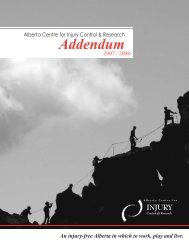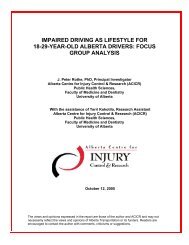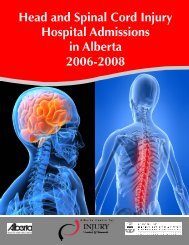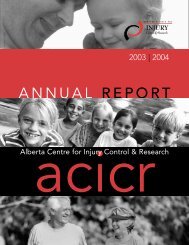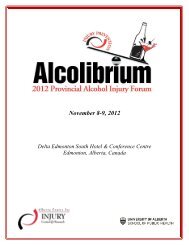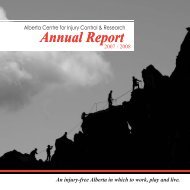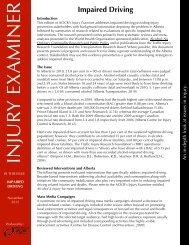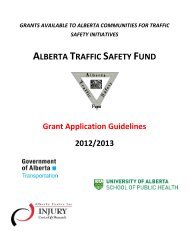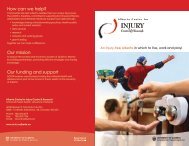JUNE 2003 - Alberta Centre for Injury Control & Research
JUNE 2003 - Alberta Centre for Injury Control & Research
JUNE 2003 - Alberta Centre for Injury Control & Research
Create successful ePaper yourself
Turn your PDF publications into a flip-book with our unique Google optimized e-Paper software.
SUMMARY AND IMPLEMENTATION<br />
RECOMMENDATIONS<br />
<strong>Alberta</strong>’s injury challenge is significant. This <strong>Alberta</strong> <strong>Injury</strong> <strong>Control</strong><br />
Strategy describes the specific challenges and identifies the key directions<br />
that the province needs to take to make <strong>Alberta</strong> a safer place to live. Now<br />
specific steps must be taken to bring the strategy to fruition. The following<br />
recommendations address the next steps to be taken.<br />
RECOMMENDATIONS FOR IMPLEMENTING THE ALBERTA<br />
INJURY CONTROL STRATEGY<br />
• Enhance provincial coordination and collaboration Enhance provincial<br />
coordination and<br />
collaboration<br />
Authorize and approve the <strong>Alberta</strong> <strong>Centre</strong> <strong>for</strong> <strong>Injury</strong> <strong>Control</strong> and <strong>Research</strong><br />
with a provincial mandate and broad stakeholder endorsement <strong>for</strong> injury<br />
control coordination and collaboration support. The ACICR, funded by<br />
<strong>Alberta</strong> Health and Wellness, is viewed as another “health” organization<br />
with no funding from other government ministries to support its mission and<br />
operation. The ACICR has taken a facilitative approach in working with<br />
stakeholders across the province by supporting stakeholders with specific<br />
requests and expert resources as available. Some stakeholders are not<br />
familiar with the ACICR. With policy support from all provincial<br />
government ministries and other stakeholders, the profile and coordination<br />
role of the ACICR can be enhanced. The preferred coordination and<br />
collaborative role to be taken by the ACICR needs to be agreed upon by<br />
stakeholders in injury control, including the role of the ACICR in the<br />
<strong>Alberta</strong> <strong>Injury</strong> <strong>Control</strong> Strategy.<br />
• Develop and sell the business case Develop and sell<br />
the business case<br />
Preventable injuries cost <strong>Alberta</strong>ns billions of dollars annually in both direct<br />
and indirect costs. Evidence exists on effective interventions to prevent<br />
injuries and to manage injuries effectively when they occur. Through the<br />
coordinated leadership of ACICR and other stakeholders, develop a<br />
compelling business case to rein<strong>for</strong>ce the cost benefits of effective injury<br />
prevention programs, followed by effective treatment, management and<br />
rehabilitation services. Such evidence will be critical to obtaining support<br />
<strong>for</strong> implementation of the <strong>Alberta</strong> <strong>Injury</strong> <strong>Control</strong> Strategy.<br />
• Develop an implementation plan Develop an<br />
implementation plan<br />
Entrust the coordinating body of ACICR and a broadened advisory body of<br />
stakeholders to develop a plan <strong>for</strong> implementing the <strong>Alberta</strong> <strong>Injury</strong> <strong>Control</strong><br />
Strategy. The plan needs to identify specific injury priorities and initiatives<br />
on an annual basis, designating and obtaining agreements on specific<br />
stakeholder responsibilities and accountabilities.<br />
Making <strong>Alberta</strong> the Safest Place to Live<br />
56



